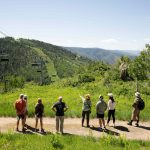City Council: Shift funding focus away from Gondola Transit Center

Steamboat Pilot & Today file photo
Steamboat Springs City Council members have directed a shift to the long-stalled Gondola Transit Center project, opting to no longer keep the base-area redevelopment project as its sole top redevelopment priority.
Instead, council directed the Urban Renewal Authority Advisory Committee at its Sept. 16 meeting to start moving forward with other lower-priority redevelopment projects — aiming to balance progress after years of delays and budget uncertainties tied to the Gondola Transit Center, or GTC.
The 15-member Urban Redevelopment Authority Advisory Committee (URAAC) makes advisory recommendations to the Steamboat Springs Redevelopment Authority (SSRA) on matters related to the implementation of the Steamboat Springs Base Area Reinvestment Plan.
For nearly four years, the GTC overhaul has absorbed much of city council’s attention and dedicated Urban Renewal Area dollars. The project, which aims to transform how people access the mountain and move around the base area, remains complicated by unresolved questions over bus berth design, snowmelt system needs and city climate codes that restrict fossil fuel use for outdoor heating.
Due to these factors, other needed upgrades — sidewalks, lighting and pedestrian safety improvements — have been delayed.
At the Sept. 16 meeting of the Steamboat Springs Redevelopment Authority, several council members expressed concern that holding funds back for a GTC consensus that remains elusive was preventing progress on other fronts, urging the advisory committee to prepare an updated budget proposal that includes a broader set of projects ready for construction, allowing visible improvements even as GTC planning continues.
The meeting last week began with a presentation by SSRA Project Manager Gates Gooding, who gave an overview of 2025 project activities.
At the center of the ongoing GTC debate are two bus berth designs, explained Gooding: a city staff-preferred “pull-through” option that is less costly and more flexible for future buses, but requires passengers to cross moving traffic, and Ski Corp.’s favored “sawtooth” design that offers direct plaza access, but limits bus sizes and increases costs considerably — as well as the overall environmental footprint — due to snowmelt requirements far surpassing that of the pull-through design.
The snowmelt issue remains particularly complex, said Gooding, after city council members voted to ban snowmelt systems powered by fossil fuels in a December 2013 vote. That decision pushed the project team to explore other solutions while awaiting the preliminary results of a geothermal feasibility study, set to come out by the end of the year.

“We feel it’s premature to force alignment on this. We’d all love for alignment to come as quickly as possible, but we’re starting to see a risk where if alignment slips much further than now, then we’re going to start looking at potentially missing the final outside date of the project,” said Gooding, who noted a “final date” of the end of 2027 by which both parties — the city and Ski Corp. — must be under contract to build the GTC.
“If either partner misses that deadline, then either can elect to cancel that agreement,” he added. “Both partners can also decide together to extend, but at this point, it’s not clear what the risk is that one partner or the other may decide not to move forward.”
Gates explained that over the summer, the project team looked into alternative power sources for snowmelt systems, ultimately concluding that electric boilers and electric snowmelt heat cables are the only feasible options beyond geothermal — which still may prove infeasible following the results of the study.
“(Ski Corp.) has agreed that electric boilers would be an acceptable backup option if geothermal proves infeasible, but that’s conditional on first finding out from (the Yampa Valley Electric Association) if their electrical system would support this additional load without constricting future base area redevelopment, and we are still waiting on further information form YVEA,” he said.
Regarding the Complete Streets Segment of the project — constructing a missing sidewalk segment along the inside of Mt. Werner circle, as well as median upgrades and new lighting — Gooding announced that Alterra, Ski Corp.’s parent company, has granted the project team easements at no cost, allowing that portion of the project to move forward in 2026.
Following the presentation, councilors dove into a discussion about the competing visions for the GTC, the city’s redevelopment priorities and how best to leverage limited funds for other improvements.
Councilor Amy Dickson pointed to ongoing pushback to renewable sources from some URAAC members advocating for a waiver to use natural gas — the simplest, cheapest and most reliable option for GTC snowmelt.
Councilor Michael Buccino suggested that the natural gas issue is a “debate we need to have,” adding that when the preliminary results of the geothermal feasibility study are announced, he will bring up the viability of the natural gas option nonetheless.
“We are in a climate crisis, and the thought of even entertaining heating our outdoor sidewalks with fossil fuel – I mean, a new report just came out this week around the carbon emissions,” Dickson responded. “What a black mark on council, on Ski Corp., if we were ever to move forward with that.”
Gooding then gave an overview of the 2026 project activity plan and proposed budget.
“We have approximately $35 million for projects (for 2026),” he said. “The commitment to the GTC project is $20 million, but in reality, the estimated budgets are significantly higher than that and we’re not sure where it might actually come in.”
“It is a very expensive project, but it also does transform the entire base area,” he continued. “It really should reconfigure the way people get around the entire base area, so it is a big transformational project regardless of which berth alignment we end up building.”
That leaves $15 million potentially leftover for other projects in 2026 — but, as Gooding explained, the redevelopment authority is uncertain how much of that will need to be used to “to do the GTC project the right way,” and for that reason, the committee is recommending a “conservative approach” to the 2026 budget.
“Every time we go to the committee and ask them about this, they are unanimous in saying, ‘We want to do the GTC the right way, that’s the number one project, and if we have to choose, we’d rather not do these lower-priority projects, let’s just get the GTC done,'” he said. “But it comes at the expense of waiting, and the longer the GTC project’s delayed, the longer we’re just sitting around and not implementing projects and not deploying this fund we have for improvements.”
Dickson and Councilor Dakotah McGinlay both raised concerns regarding concentrating so much redevelopment authority funding on the GTC given the continued delays.
“I just worry … that that money could be better utilized and maximized throughout the other projects we’re looking at,” said McGinlay.
Councilor Bryan Swintek was blunt in his opposition to the conservative budget approach, urging that holding funds hostage for the GTC’s design preferences discourages progress on other needed improvements.
“I think this conservative approach creates no incentive for the parties to come together to find a solution for the GTC … I think the best incentive would be for us to say, ‘Let’s continue to fund other projects on this list,’ meaning you don’t have an endless buffer of money that when you hold out long enough, you get what you want, but you should come to an agreement sooner than later so that you get something built,” he said.
“It’s not just money. A certain group knows exactly what they want, and they want to play the game,” Swintek added. “Go down this list (of other projects), pick some things and start building them.”
The meeting closed with a clear indication that council intends to broaden the redevelopment authority’s focus beyond the Gondola Transit Center, encouraging tangible progress on secondary projects while supporting the continued technical studies and partnership negotiations necessary to move the GTC forward.
Nov. 18 will bring a critical budget session where URAAC must present a revised project and funding plan to balance immediate community needs with long-term redevelopment goals — a plan that council hopes will finally translate years of planning into visible enhancements.

Support Local Journalism

Support Local Journalism
Readers around Steamboat and Routt County make the Steamboat Pilot & Today’s work possible. Your financial contribution supports our efforts to deliver quality, locally relevant journalism.
Now more than ever, your support is critical to help us keep our community informed about the evolving coronavirus pandemic and the impact it is having locally. Every contribution, however large or small, will make a difference.
Each donation will be used exclusively for the development and creation of increased news coverage.










